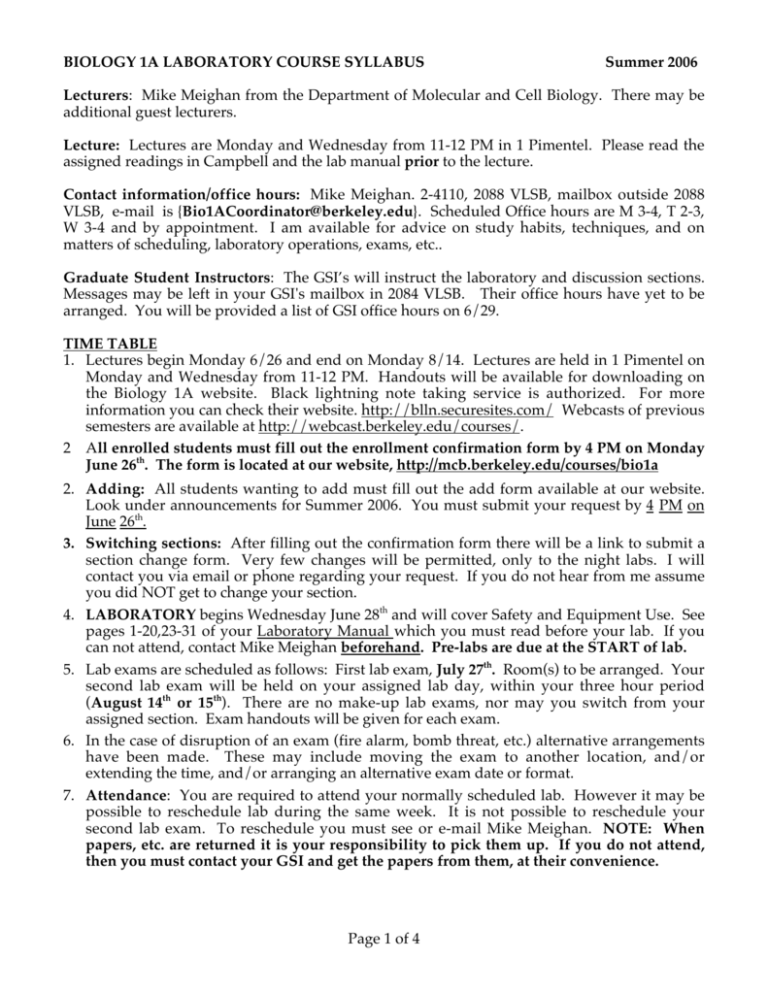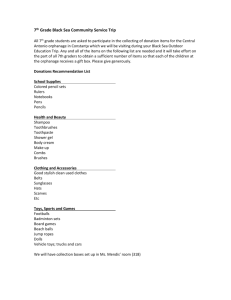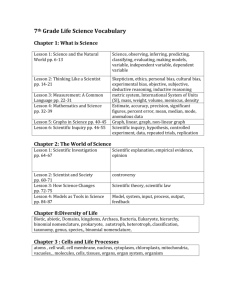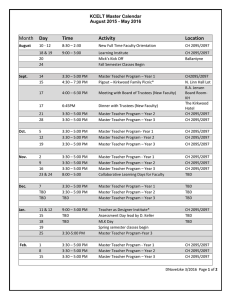Page 1 of 4 BIOLOGY 1A LABORATORY COURSE SYLLABUS
advertisement

BIOLOGY 1A LABORATORY COURSE SYLLABUS
Summer 2006
Lecturers: Mike Meighan from the Department of Molecular and Cell Biology. There may be
additional guest lecturers.
Lecture: Lectures are Monday and Wednesday from 11-12 PM in 1 Pimentel. Please read the
assigned readings in Campbell and the lab manual prior to the lecture.
Contact information/office hours: Mike Meighan. 2-4110, 2088 VLSB, mailbox outside 2088
VLSB, e-mail is {Bio1ACoordinator@berkeley.edu}. Scheduled Office hours are M 3-4, T 2-3,
W 3-4 and by appointment. I am available for advice on study habits, techniques, and on
matters of scheduling, laboratory operations, exams, etc..
Graduate Student Instructors: The GSI’s will instruct the laboratory and discussion sections.
Messages may be left in your GSI's mailbox in 2084 VLSB. Their office hours have yet to be
arranged. You will be provided a list of GSI office hours on 6/29.
TIME TABLE
1. Lectures begin Monday 6/26 and end on Monday 8/14. Lectures are held in 1 Pimentel on
Monday and Wednesday from 11-12 PM. Handouts will be available for downloading on
the Biology 1A website. Black lightning note taking service is authorized. For more
information you can check their website. http://blln.securesites.com/ Webcasts of previous
semesters are available at http://webcast.berkeley.edu/courses/.
2 All enrolled students must fill out the enrollment confirmation form by 4 PM on Monday
June 26th. The form is located at our website, http://mcb.berkeley.edu/courses/bio1a
2. Adding: All students wanting to add must fill out the add form available at our website.
Look under announcements for Summer 2006. You must submit your request by 4 PM on
June 26th.
3. Switching sections: After filling out the confirmation form there will be a link to submit a
section change form. Very few changes will be permitted, only to the night labs. I will
contact you via email or phone regarding your request. If you do not hear from me assume
you did NOT get to change your section.
4. LABORATORY begins Wednesday June 28th and will cover Safety and Equipment Use. See
pages 1-20,23-31 of your Laboratory Manual which you must read before your lab. If you
can not attend, contact Mike Meighan beforehand. Pre-labs are due at the START of lab.
5. Lab exams are scheduled as follows: First lab exam, July 27th. Room(s) to be arranged. Your
second lab exam will be held on your assigned lab day, within your three hour period
(August 14th or 15th). There are no make-up lab exams, nor may you switch from your
assigned section. Exam handouts will be given for each exam.
6. In the case of disruption of an exam (fire alarm, bomb threat, etc.) alternative arrangements
have been made. These may include moving the exam to another location, and/or
extending the time, and/or arranging an alternative exam date or format.
7. Attendance: You are required to attend your normally scheduled lab. However it may be
possible to reschedule lab during the same week. It is not possible to reschedule your
second lab exam. To reschedule you must see or e-mail Mike Meighan. NOTE: When
papers, etc. are returned it is your responsibility to pick them up. If you do not attend,
then you must contact your GSI and get the papers from them, at their convenience.
Page 1 of 4
LAB MATERIALS
Required textbook: Campbell, Biology, 7th edition.
Required Lab Manual: The required lab manual (2005/2006) is available at ASUC and Ned’s.
This is a new edition and you cannot use previous editions.
Required pre-labs and worksheets. These are available on our website or at Replica Copy, at
2140 Oxford. It is actually much cheaper and faster to buy a set instead of printing them.
Exam Reader: An exam reader with exams from past semesters and summer is available at
Replica Copy.
Required Course Reader: Handouts and images will be available on our website. Usually the
Monday and Wednesdays lectures will be posted by the previous Friday by 5 P.M.
GRADING PROCEDURE: Grades will be determined numerically as follows:
Laboratory & Discussion as follows:
Lab Exam 1, 7/27 in lecture (covering labs 1 - 6)
90 pt’s.
Lab Exam 2, 8/14 or 15 (covering labs 7 - 11)
75 pt’s.
Lab Quizzes - 5 points given at the start of each lab (11 labs
50 pt’s.
x 5 pts). The lowest score will be dropped, hence 10 X 5.
Total: 215 pt’s.
Changes affecting the point distribution, the reading schedule, or other aspects of the
syllabus may occur during the semester. We will inform you of any changes.
Grades are based upon the points that you EARN (not needs or wants). Guaranteed grades are:
A (some form of an A)
100-90%
D (some form of a D)
69-60%
B (some form of a B)
89-80%
F
59-00%
C (some form of a C)
79-70%
However, in the event that some examinations have been unusually difficult, the cut offs
for letter grades may be lowered (but only by a few percentage points, and as deemed
necessary). Historically around 50% of the class EARN A’s and B’s.
LAB GRADE ADJUSTMENTS: Lab exam 2 and the quiz scores will be adjusted as necessary.
This will insure that no section has an advantage (higher quiz scores or higher lab exam 2
scores) nor has a disadvantage (lower quiz scores or lower lab exam 2 scores). They will be
adjusted based upon lab exam 1 scores and will be adjusted to the easiest of the sections. More
information about this is available on our website. After making the adjustments the total
points is then determined for each student. We look at 90% of the total points and see what %
of the students have earned a guaranteed A+/A/A-. If there are fewer than about 20% we then
typically lower the number of points required for some form of an A (since it is the lower end it
would be A-). We continue to do that for each guaranteed grade range, B, C and D. If need be,
we lower the total number of points necessary for a certain grade. We usually give out about
20% A’s, 30% B’s, 20% C’s, 10% D’s and 10% F’s. We then go back and make the exact cut-offs
for each form of a grade (eg. C+, C, C-). We then look to at each student's score to determine if
they are within 3 points of the next higher grade. If so then we determine if they should be
“bumped” to the next higher grade. The most important criteria for this “bump” in the summer
is attendance and participation in lecture/lab/discussion (pre-labs/worksheet averages). We
only consider bumps if you are within 3 points. On average about 50% of the students who are
within 3 points get bumped, 50% do not. Note that the class is, in a sense, curved. But we
would rather that you strive to earn the guaranteed percentages, instead of us having to lower
the percentage cutoffs for given grades.
Page 2 of 4
I GRADES: In keeping with University regulations, the grade of "incomplete" is assigned to a
student only if the student has completed at least one-half of the material with a passing grade
of C or better and the student presents documented medical evidence of their inability to
complete the course on schedule. The student assigned an I grade in Biology 1A must complete
the work before the first day of classes in the Spring Semester of 2007, without including the
course for units on the study list, or the I lapses to an F.
CHEATING: The rare student found cheating in the course will be reported to the University
for review for dismissal. An automatic 0 will be given on that assignment. Cheating is not
tolerated. This includes ALL work—including pre-labs! Students repeating the class must do
the work this semester and cannot turn in work from previous semesters. DON'T CHEAT, it
isn't worth it because we will take the time to submit the case to the student conduct office.
RECOMMENDATIONS: It is probably better for you to obtain letters from upper division
classes, in the future, but we are willing to write letters.
HOW TO DO WELL
1. Come to lecture and take notes. Review them. Read the assigned reading before lecture.
Attending lecture does not replace reading the lab manual and the textbook.
2. Keep up with the material. Seek help if needed.
3. Clarify topics you do not understand by
a. Coming to office hours and asking questions.
b. Forming a study group.
c. Doing the reading.
d. Emailing questions. This is probably the least effective method.
4. Use the exam reader, making sure you understand the reasoning behind the answers.
5. Be prepared for lab and be prepared to think.
BIOLOGY 1A STUDY RESOURCES
Please take advantage of these resources. Additional opportunities such as reviews may also be
held. Further information is available in the lab manual and the Exam Reader.
Office Hours—they typically are very helpful.
Student Learning Center (SLC, 189 Chavez Student Center): The SLC may offer student-led
study groups and tutoring. See their website for more information (slc.berkeley.edu).
STUDY GROUPS: These are usually a great way to learn. I encourage you to form study
groups, either within your lab or with students from other sections.
Reading: It helps to read before the lab lecture. The lab lecture does not replace reading.
Tutors (fee): Formal tutoring (variable fees) from individuals may be available. Contact Mike.
URLs: http://mcb.berkeley.edu/courses/bio1a, http://webcast.berkeley.edu/courses/
Lab Times and Room Locations (all in VLSB)
Lab # Time
101
T/Th 9:30-12:30 PM
102
T/Th 9:30-12:30 PM
103
T/Th 2:00- 5:00 PM
104
T/Th 2:00- 5:00 PM
Room
2095
2097
2095
2097
Lew
Takata
Weitze
Dutton
Lab # Time
105
M/w 2:00- 5:00 PM
106
M/w 2:00- 5:00 PM
107
M/W 6:30- 9:30 PM
108
M/W 6:30- 9:30 PM
Contact Information
Lew, Helen
helenlew@berkeley.edu
Weitze, Scott
Takata, Steve
Steve_takata@yahoo.com Dutton, Marianne
Page 3 of 4
Room
2095 Lew
2097 Takata
2095 Weitze
2097 Dutton
sweitze@sfsu.edu
nefarious_md@yahoo.com
Note: You must read the assigned reading in the lab manual and also the assigned reading in
Campbell. Lab lecture does not replace reading the lab manual.
Date
6/26
6/28
Lect # Lecture Topic
1
First Lecture – introduction.
2
Safety, equipment and ligation
(pages 1-31).
Reading Campbell
No Reading.
7th ed. p. 26-27, 86-89,
94-99, 296-298
7/3
7/5
3
NO Monday lecture.
No lab.
Transformation and cells (pages 7th ed. Ch. 6.
33-56)
7/10
4
Enzymes
7/12
5
Photosynthesis
7/17
6
Genetics and Molecular Biology I
7/19
7
Genetics and Molecular Biology II
7/24
8
Invertebrates I
7/26
7/27 Th
9
Q & A (if you want)
7/31
10
Invertebrates II.
8/2
11
Rat Anatomy.
8/7
12
Chordate Diversity
7th ed. 671-701.
8/9
13
Reproduction and development
7th ed. 968-975,987-1001.
8/14
14
Q & A (if you want)
Reading Lab Manual
No lab.
Lab 1: Safety and Equipment.
Pages 1-20, 23-31.
No lab.
Lab 2: Ligation reaction and
Cells. Pages 21-22, 33-56.
7th ed. 68-74, 77-86 & Ch. 8. L a b
3:
Enzymes
and
Transformation. Pages 33-39,
57-75.
7th ed. Ch. 10.
Lab 4: Complementation and
Photosynthesis. Pages 77-96.
7th ed.
Ch. 20.
7th ed.
Ch. 20.
Chs. 12-17, 346-350, Lab 5: Genetics & Mol. Biol. I.
Pages 97-114.
Chs. 12-17, 346-350, Lab 6: Genetics & Mol. Biol. II
Pages 115-134.
7th ed. 633-661, 820-827, 831- Lab 7: Invertebrates I.
833, 844-855, 867-871,884-887, Pages 135-156.
922-933, 1011-1012.
Lab Exam 1 = 7/27. 12:30-2.
7th ed. 656-669.
Lab 8: Invertebrates II. Pages
157-168.
7th ed. 855-862, 869-878, 886- Lab 9: Anatomy.
889, 891-894, 931-936, 968-973. Pages169-178.
Lab 10: Diversity.
Pages 191-206.
Lab 11: Reproduction.
Pages 179-190.
Lab Exam II –during your lab.
During your 3 hour lab.
Reading assignments are from Campbell, 7th edition and the 2005-2006 lab manual.
Lab: Daily lab quizzes worth a total of 50 pts (11 X 5 pts minus the lowest score) will be given
at the start of each lab. Pre-labs are required in order to do lab. Worksheets are also required.
Lab exam 1 worth 90 points will be held from 12:30-2 PM on Thursday July 27th. It will cover
labs 1-6. Lab exam 2, worth 75 pts, covers labs 7– 11 and will be given in your lab, either Aug.
14th or 15th.
Page 4 of 4






